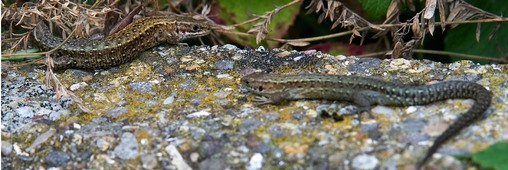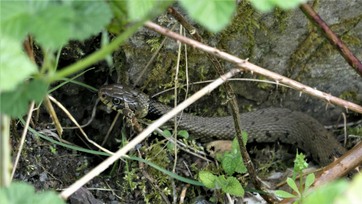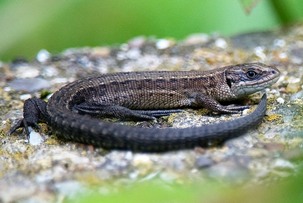

Biodiversity
Action
Plan

Reptiles. A Grass Snake slithering into the water, a Common Lizard basking on a bare patch in the heath; these are welcome sights.
All native reptile species in England have declined in numbers and been lost from many areas, primarily due to habitat loss, degradation and fragmentation; they are all a national conservation priority.
Grass Snake and Common Lizard are present in some numbers in Barnsley. There are a few records of Slow Worm in Barnsley, and previous records of Adder, but not recent.
Reptiles spend their time on land, foraging, sheltering, and hibernating; they require both plenty of cover and, being cold-blooded, warm sites for basking to raise their body temperature. Heath, dry grasslands and indeed brownfield sites often provide these. Reptiles are generally not found in intensively managed farmland and highly built-up areas.
Grass Snake, the largest British snake, differs in its preference for wetlands from other reptiles. Grass Snake are found in undisturbed habitats in the river corridors of the Dove and Dearne. They can be seen around ponds, preying on frogs and other amphibians, and found inside a compost heap or beneath rotting leaves and reeds where they seek the warmth for their eggs.
The Common or Viviparous Lizard, so called because it give birth to live young, feeds on invertebrates such as insects, spiders and woodlice. In Barnsley it is found both on upland heath and brownfield sites in the Dearne Valley.
Grass Snakes can forage over fairly large distances while Common Lizards stay close to small landscape features such as grass banks, dry stone walls and basking areas with cover nearby.
For further information on distribution, conservation and actions please follow the following links …
Local Priority Species. The two main reptile species found in Barnsley are:
Grass snake (Natrix natrix
Common or Viviparous Lizard (Zootoca vivipara).
The other two reptile species that may be recorded in Barnsley are:
Slow worm (Anguis fragilis)
Adder (Vipera berus)
These are all UKBAP 2007 priority species and Section 41 species of principal importance.
Adder is considered ‘Vulnerable’ to extinction in England in the Amphibian & Reptile Conservation Trust report in 2021. The other reptile species that may be found in Barnsley are not considered to be threatened by extinction.
ARC Trust Red list report 2021
Grass Snake and Common Lizard are local priority species due to their national status and because there are sites in Barnsley with good populations which deserve conservation management.
If sites with populations of Adder or Slow worm are recorded then they would be added to the list.
In Barnsley, sites with a good population of a reptile species would be considered for Local Wildlife Site (LWS) status.
A good population of a reptile (Grass Snake or Common Lizard) would have 5 or more-individuals. 20 or more Grass Snakes would be exceptional as would more than ten Common Lizards.


Reptiles